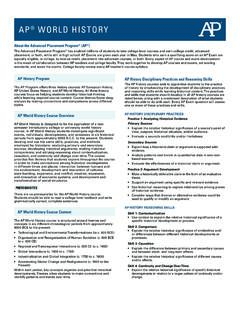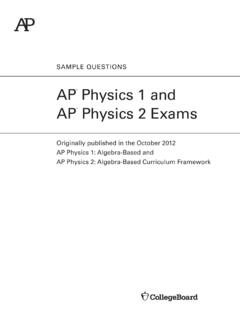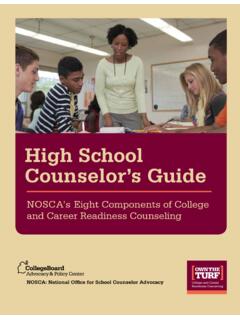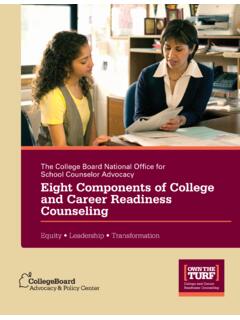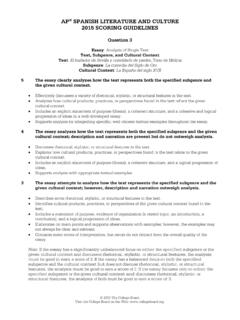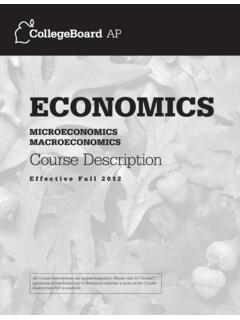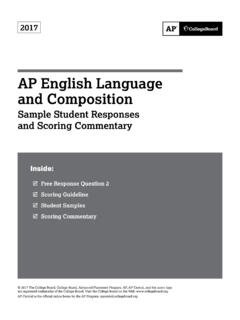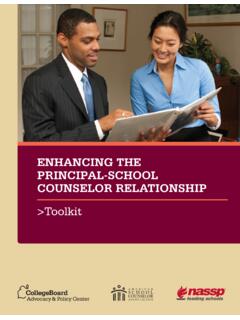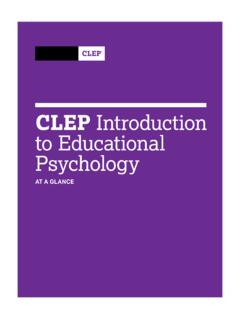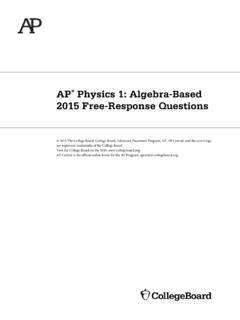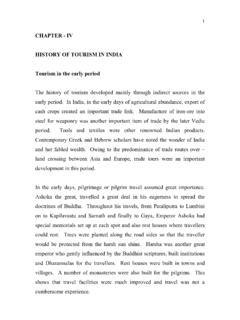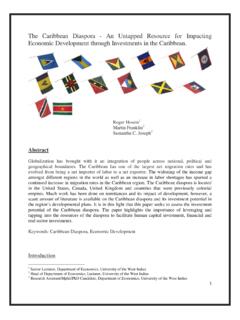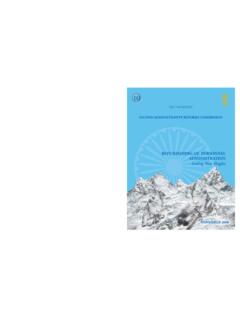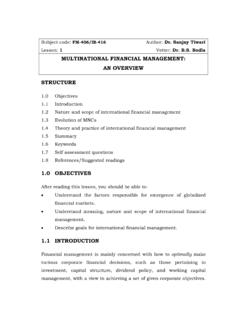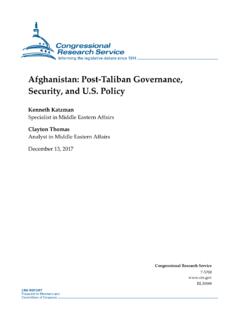Transcription of AP World History - College Board
1 2017AP World HistorySample Student Responses and Scoring Commentary 2017 The College Board . College Board , Advanced Placement Program, AP, AP Central, and the acorn logo are registered trademarks of the College Board . Visit the College Board on the Web: Central is the official online home for the AP Program: : RDocument-Based Question RScoring Guideline RStudent Samples RScoring Commentary AP World History 2017 SCORING GUIDELINES 2017 The College Board . Visit the College Board on the Web: Question 1 Document-Based Question Maximum Possible Points: 7 Evaluate the extent to which religious responses to wealth accumulation in Eurasia in the period circa 600 to 1500 differed from state responses to wealth accumulation. Points Scoring Criteria Notes A: Thesis and Argument Development 0 -2 Thesis: Presents a thesis that makes a historically defensible claim and responds to all parts of the question.
2 The thesis must consist of one or more sentences located in one place, either in the introduction or the conclusion. (1 point) Acceptable thesis statements must EXPLICITLY address a difference between at least one aspect of religious responses and at least one aspect of state responses to wealth accumulation in Eurasia during the period circa 600 to 1500 Commonly seen examples might include: Religious and state responses to wealth accumulation differ in that religious responses encouraged the rejection of wealth to obtain salvation or create harmony, while state responses were to regulate the accumulation of wealth through administrative functions or state sponsored hierarchies. States responded to wealth accumulation by creating bureaucracies and laws that protected trade.
3 This differed from religious responses which encouraged the wealthy to redistribute wealth and strengthen the religious organization. Argument Development: Develops and supports a cohesive argument that recognizes and accounts for historical complexity by explicitly illustrating relationships among historical evidence such as contradiction, corroboration, and/or qualification. (1 point) Students earn the point by noting that there are a variety of state and religious responses to wealth accumulation, while also corroborating the thesis statement or overarching argument consistently and cohesively throughout the essay with multiple pieces of evidence. AP World History 2017 SCORING GUIDELINES 2017 The College Board . Visit the College Board on the Web: Question 1 Document-based Question (continued) B: Document Analysis 0-2 Document Analysis (Content): Utilizes the content of at least six of the documents to support the stated thesis or a relevant argument.
4 (1 point) See document summaries for details. Doc. 1: The Chronicle of Zuo, ca. 350 Doc. 2: Chanakya, Arthashastra, ca. 250 Doc. 3: Cicero, Essay about Duties, ca. 50 Doc. 4: Gerontius, Life of Melania, ca. 450 Doc. 5: The Qur an Doc. 6: Bezeklik Buddhist painting, ca. 800 Doc. 7: Ganapatideva, edict, ca. 1245 Commonly seen examples might include: Content (Doc. 1): The Chronicle of Zuo allowed Chinese merchants to accumulate as much wealth as possible so long as they didn t try to topple the ruler. Sourcing (Doc. 1): It makes sense that Doc. 1 would allow merchants to gain a lot of wealth in an attempt to preserve the political power of the ruler. The climate of fear at this tumultuous time likely caused the government to be more accepting of rich traders.
5 Content (Doc. 4): The life of Melania the Younger shows that Christianity encouraged successful merchants to give away their wealth to the needy and to monasteries, as was done by this saint. Sourcing (Doc. 4): Because the purpose of the biography was to tell a positive story about the life of Melania, Doc. 4 likely exaggerated the amount of wealth given away by the saint. Document Analysis (Sourcing): Explains the significance of the author s point of view, author s purpose, historical context, and/or audience for at least four documents. (1 point) C: Using Evidence Beyond the Documents 0-2 Contextualization: Situates the argument by explaining the broader historical events, developments, or processes immediately relevant to the question. (1 point) This point can be earned by explaining historical events, developments, or processes that occur before, during, or continue after the time frame of the question.
6 Commonly seen examples might include: The rise of empires and the development of imperial administrations. The rise and spread of religions; foundational beliefs regarding salvation and living the good life of major religious traditions. The growth of interregional trading networks across Afro-Eurasia and corresponding rise in the economic and social prominence of merchants. AP World History 2017 SCORING GUIDELINES 2017 The College Board . Visit the College Board on the Web: Question 1 Document-Based Question (continued) Evidence beyond the Documents: Provides an example or additional piece of specific evidence beyond those found in the documents to support or qualify the argument. (1 point) Commonly seen examples might include: Other rulers or empires that promoted commerce ( , Mongols, Ming) Other communities that were involved in commercial activity ( , Jews, Sogdians) Other examples of religious traditions that either championed or expressed doubts about wealth accumulation ( , Greek belief systems, or Hindu, or Christian asceticism) D: Synthesis 0-1 Synthesis: Extends the argument by explaining the connection between the argument and either a development in a different historical period geographical area course theme and/or approach that is not the focus of the essay, or a different discipline.
7 (1 point) Commonly seen examples might include: Different period ( , Protestant views on wealth and economic success) Different region ( , Aztec or Inca policies such as road building or the pochteca system) Different theme ( , analysis of environmental factors that suggests that in some regions commerce was the predominant occupation, and argues that religions and states in such regions adapted to that situation) Different discipline ( , a sociological approach to argue that both religions and states were concerned about the economic inequalities and social upheaval that unrestricted commercial wealth might bring) If response is completely blank, enter - - for all four score categories A, B, C, and D. AP World History 2017 SCORING GUIDELINES 2017 The College Board .
8 Visit the College Board on the Web: Question 1 Document-Based Question (continued) Document Summaries Document Content Sourcing 1. The Chronicle of Zuo, ca. 350 A Chinese state official refuses the request of an ambassador from another Chinese state to confiscate merchant property and claims that his state does not interfere in the commercial activities of merchants so long as they are loyal to the ruler. The chronicle relates the viewpoints of a state official (POV) Historical chronicle that would have primarily been read by government officials (audience) Diplomacy and competition between Chinese states during the Warring States period (context) 2. Chanakya, Arthashastra, ca. 250 Advocates for regulating commercial activity within the Mauryan Empire by ordering the fixing of prices and government supervision of merchants and their goods.
9 Government official concerned about unregulated commerce (POV) Treatise aimed at rulers and other members of the government elite (audience) Wants to establish government supervision of merchants to ensure social stability within the empire and to ensure proper taxation (purpose) 3. Cicero, Essay about Duties, ca. 50 Promotes agriculture as the best and most moral occupation while arguing that the occupations of merchants and moneylenders are vulgar and unsuitable for gentlemen. Member of the Roman elite advocating for maintaining the traditional agrarian foundations of the Roman state (POV) Members of the Roman elite (audience) Political turmoil during the late Republican period, growth of interregional and transregional trade and growing profits for merchants (context) 4.
10 Gerontius, Life of Melania, ca. 450 Relates the story of how an early Christian saint and her husband, both of whom came from wealthy Roman families, relinquished their wealth and donated most of it to the church because they realized that wealth comes from the devil. Monk using a story about an early Christian saint to advocate for the renunciation of wealth and for donating wealth to the church (POV) Other monks, clergy, and Christian elites (audience) Early development of Christianity, growth of monasticism (context) 5. The Qur an States that some accumulated wealth should be given as charity for those less fortunate. Assures believers that if they fulfil this duty God will provide for them. The Muslim community (audience) Early development and spread of Islam (context) To establish guidance for the Muslim community about using wealth to help others (purpose) AP World History 2017 SCORING GUIDELINES 2017 The College Board .
